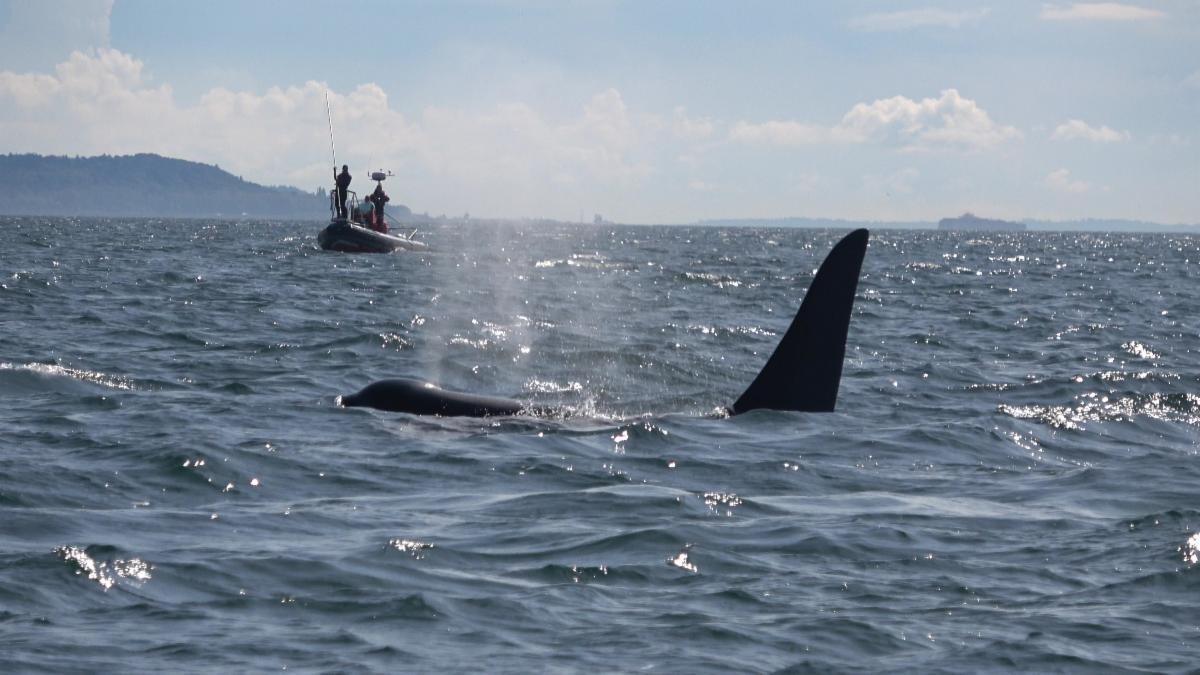Deep-sea doctor appointments could help pinpoint problems in endangered whale species

Determining a whale’s health can be tricky, but a team of researchers and scientists working through a locally secured grant are developing non-invasive wellness checks on an endangered species that could shed light on why its population is at risk.
A team of National Oceanic and Atmospheric Administration (NOAA) biologists following a population of 73 Southern Resident killer whales off the coast of Washington state earlier this month began working with scientific advisers on a method of capturing the animals’ health data in real time.
The hands-free approach blends objective and subjective observations about individual whales with unique means of data and sample collection, including scouting out infections with thermal cameras and flying drones equipped with petri dishes into the misty exhalation, or “blow,” of a cetacean to check for respiratory problems.
Dr. Alissa Deming, vice president of conservation medicine and science for Laguna Beach’s Pacific Marine Mammal Center, awarded a $55,000 grant in 2020 from the National Fish and Wildlife Foundation that made the work possible, said the project aims to develop a process for deftly delivering deep-sea checkups.
“Biologists have already established ways to assess body conditions, and they’ve done a really great job at it,” Deming said. “This just adds another layer to that.”
Awarded through NFWF’s Killer Whale Research and Conservation Program, the grant let biologists in the field collaborate with PMMC and the Washington-based nonprofit SeaDoc Society to collect data over a two-week period that wrapped last Friday.
“This award is a major milestone in [our] expanding reach and impact on ocean health and conservation,” PMMC chief executive Peter Chang said in an earlier statement. “We are excited about this collaborative effort in terms of what it can do for this critically endangered population of whales.”
While the work is being conducted on a small population of orcas that migrates along the Pacific Coast and spends summer and fall in Puget Sound, Deming says the process could have wider applications.
“The things being developed with Southern Resident killer whales will hopefully be a way we can do a doctor’s appointment on a whale here that has an entanglement,” she said of baleen species frequently imperiled by nets and lines.
Dr. Joe Gaydos, a UC Davis wildlife veterinarian and scientific director for the SeaDoc Society, said essentially creating medical records and tracking data over time can inform scientists about the health of the entire population, the threats it faces and whether conservation efforts are working.
“We don’t want information just for information’s sake,” he said. “The goal is to say what can we do differently, or what can we do better to help save this population.”
For example, Southern Resident killer whales, whose diet relies heavily on Chinook salmon, have recently been discovered to have high toxin levels. Boats and other vessels also scare pods away from salmon runs and make it harder to hunt.
Knowing whether health factors contribute to declining population can help scientists recommend policies and regulations that may affect positive change, Gaydos said.
On an individual level, identifying an infection in a female whale of calf-bearing age and treating it in time could have a direct influence on population size.
“When your kids are sick, you need to take them to the doctor to get more information — you don’t know what to do until then,” Gaydos explained.
“You have to develop the tools to look at these things first,” he continued. “That’s what we’re doing, developing the tools.”
All the latest on Orange County from Orange County.
Get our free TimesOC newsletter.
You may occasionally receive promotional content from the Daily Pilot.




